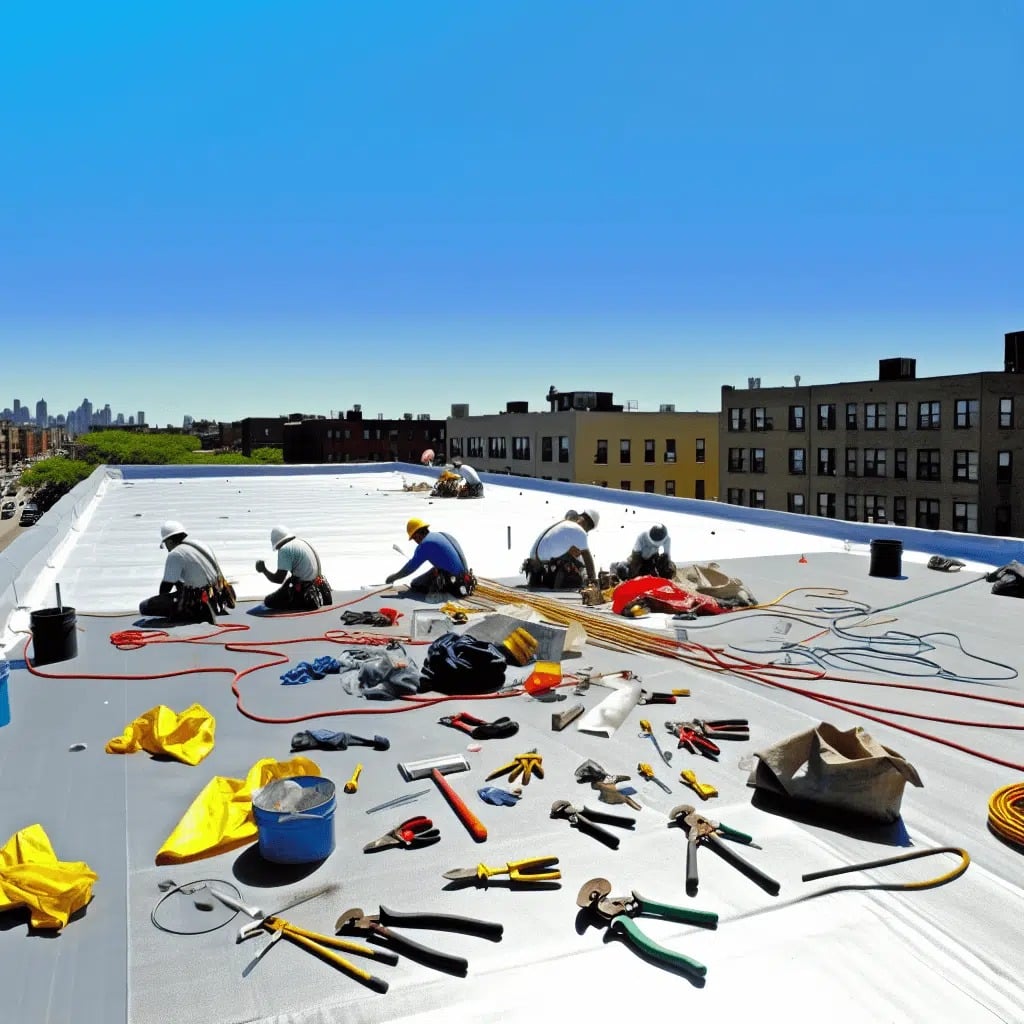The Essential Role of Underlayment in Tile Roofing
When it comes to protecting your home from the elements, the roof over your head plays a pivotal role. Yet within the roof’s construction lies an unsung hero – the underlayment for tile roofs. This layer, often hidden beneath the aesthetically pleasing tiles, is what truly stands between your living space and the harsh weather conditions outside. In Cranston, RI, where the spring season brings a mix of sun and storms, the right underlayment is not just a recommendation; it’s a necessity. Ignoring this crucial element of roofing could spell disaster in the form of leaks, mold, and costly repair bills.
Spring in Cranston: A Season of Roofing Vigilance
As the snow melts and the spring rains begin, roofs across Cranston, RI, are put to the test. Those with a strong, properly installed underlayment can rest easy knowing their homes have an added layer of defense. Homeowners should be mindful that during this season, the risk of water intrusion is at its peak, emphasizing the urgency of a well-prepared roofing system. If your home’s defense against the elements is compromised, now is the time to act, not when the first signs of leaks become apparent. Remember, a robust underlayment is your home’s shield, discreetly working to ensure your peace of mind throughout the season’s unpredictable weather shifts.
Understanding the Protection Beneath the Tiles
Your roof’s tiles may catch the eye, but it’s the underlayment that often catches the brunt of nature’s fury. This barrier plays a crucial role in your home’s defense strategy, providing an essential layer of protection from water damage. As a homeowner, understanding the importance of this layer is critical; its quality and proper installation can significantly influence the overall integrity of your roofing system. It’s not simply a matter of having an underlayment; it’s about ensuring that it’s up to the task of guarding your home against whatever the skies may bring. Drawing on the experiences of seasoned roofing professionals, we see time and again that a well-chosen and correctly installed underlayment can be the difference between a roof that lasts decades and one that falters prematurely.
Navigating Your Choices in Roof Underlayment
Selecting the appropriate underlayment for your tile roof is more than a mere choice; it’s a decision that carries implications for the durability and performance of your roofing system. With a range of materials available, from traditional felt to innovative synthetic options, understanding the unique benefits and suitability of each is key to making an informed decision. In climates like Cranston, RI, where the weather can be capricious in spring, opting for a material that stands up to moisture and provides reliable performance is critical. Synthetic underlayments, for example, offer robust water resistance and can be an excellent choice for homeowners looking for long-term solutions. Experts agree that investing in a high-quality underlayment is a smart move that can prevent headaches and financial strain down the road.
Clarity on Climate and Roofing Needs
The local weather patterns dictate much of what is suitable for your roof. In the Northeast, where seasons bring a wide array of weather changes, material choice for your underlayment is paramount in protecting your property. Homeowners should take into account not just the immediate aesthetic appeal but more importantly, the functionality and weather readiness of their underlayment. It’s not uncommon for the spring months to unveil any shortcomings in your roof’s protection. That’s why Rinaldi Roofing provides professional assessments, ensuring that your underlayment is optimally selected and installed, in alignment with regional weather demands.
Maximizing Your Roof’s Potential
Ensuring the long-term protection of your home requires diligence, particularly when it comes to underlayment for tile roofs. Professional installation is a cornerstone of this process; it ensures that all underlayment materials function as intended, regardless of the weather they encounter. Meticulous attention to detail, from sealing around vents and chimneys to proper fastening and lapping, can be the defining factor for a reliable roofing system. Delving deeper into technical specifications, paying attention to breathability and vapor barriers can also influence your home’s ventilation and overall roofing efficacy. Always seek out reputable and experienced roofing contractors who are equipped to provide comprehensive services, from initial installation to ongoing maintenance, ensuring every layer of your roof is functioning seamlessly.
Ensuring the Longevity of Your Tile Roof
Installing the proper underlayment for your tile roof is not a task to be taken lightly, as it forms the backbone of your roofing system’s defense against the elements. Recognizing this, choosing a contractor with a solid track record, like those at Rinaldi Roofing, can make all the difference. These professionals bring a wealth of experience to the table, ensuring that every underlayment is applied with precision and care. They understand that the protection of your home against the ravages of wind, rain, and snow hinges on this vital layer. With the right guidance, your roof can withstand years of environmental exposure, keeping your home safe and sound.
Expert Installation for Optimal Performance
The process of underlayment installation is one that necessitates accuracy and attention to detail. Each roll must be laid out flat and aligned correctly, with no room for shortcuts if long-term efficacy is the goal. The overlapping of seams, the securing of fastenings – there’s a science to it all, and the experts at Rinaldi Roofing have it down to an art. By ensuring that the underlayment is installed according to the highest standards, they effectively eliminate the risk of water infiltration, which is a common issue that plagues poorly installed roofs. Thus, a meticulously installed underlayment is not a luxury; it’s an essential component of any responsible homeowner’s roofing strategy.
Wrapping Up: Your Roof’s First Line of Defense
As we conclude, let us reiterate the significance of the underlayment in safeguarding your home. This barrier is the unsung hero of your roofing system, often overshadowed by the more visible tiles but no less vital to the roof’s overall functionality. It acts as a guardian against water intrusion, a buffer against storm damage, and an extra layer of insulation for your home. To ensure you have the best protection possible, consider all aspects we’ve discussed: from selection to installation, to the longer-term benefits of choosing quality materials and expert contractors. Remember, a well-protected home begins with what’s underneath; take the time to invest in your underlayment, and it will pay dividends in the protection and durability of your tile roof.
Insights From The Experts
Tip 1:
When installing tile roof underlayment, always adhere to the manufacturer’s guidelines. This ensures the underlayment functions effectively as a secondary water barrier and can significantly extend the lifespan of your roof.
Tip 2:
The choice of underlayment material is critical; opt for options that offer maximum durability and water resistance. Synthetic underlayments, for instance, while slightly more costly, provide superior protection against leaks and weather damage, making them a wise investment.
Tip 3:
Understanding the local climate is key when selecting your underlayment. In areas with heavy rainfall or snow, consider a waterproof underlayment to safeguard against potential moisture damage that can lead to costly repairs.
Tip 4:
Regular maintenance checks are essential to ensure the integrity of your roof’s underlayment. Twice-yearly inspections can help detect early signs of wear and tear, preventing minor issues from escalating into significant problems.
Tip 5:
If you’re considering sustainable building practices, look for eco-friendly underlayment materials. Some modern underlayments are made from recycled materials and offer the same, if not superior, protection compared to traditional options.
Expert Answers to Top Tile Roofing Queries
1. What are the best practices for ensuring proper installation of tile roof underlayment?
To guarantee proper installation, ensure that the underlayment is laid flat and secure, with overlaps correctly sealed and all guidelines duly followed. Choosing a trusted professional with experience in regional roofing challenges is also crucial for achieving the best results.
2. Can you explain the importance of batten spacing when laying tile roofs?
Proper batten spacing is key to ensuring tiles fit securely and water can drain effectively, preventing damage and extending the life of your roof.
3. What should homeowners consider when choosing underlayment materials for tile roofs?
Homeowners must consider the local climate, roof slope, and the underlayment’s water-resistant and durability properties, to select the best material for long-lasting protection.
4. How does weather influence the choice of underlayment for tile roofs?
Weather extremes like heavy rain, snow, and high winds dictate the need for a more durable and water-resistant underlayment to protect against leaks and potential structural damage.
5. What maintenance tips can extend the life of underlayment and tile roofs?
Regular inspections, especially after severe weather events, and immediate repairs of any damage can significantly prolong the life of the underlayment and the tile roof.



